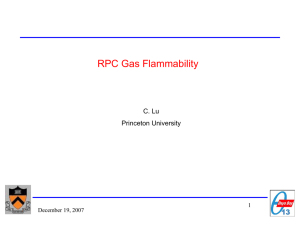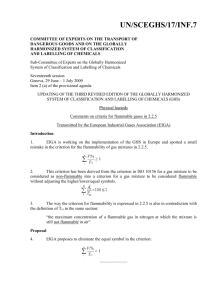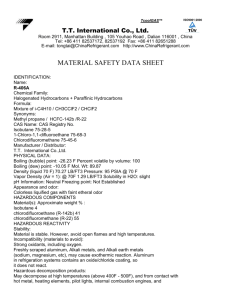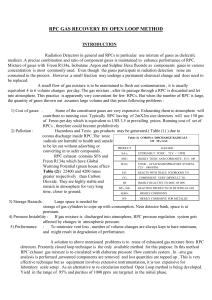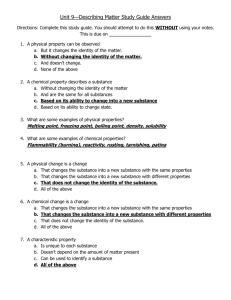DayaBayRPCGasSafety
advertisement
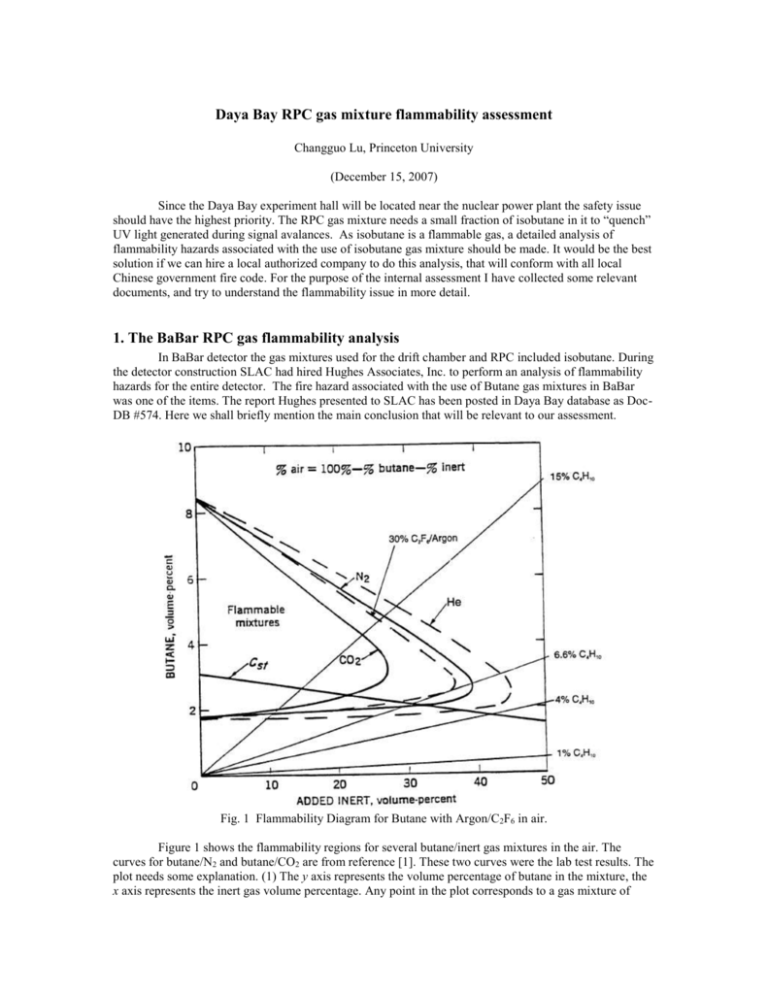
Daya Bay RPC gas mixture flammability assessment Changguo Lu, Princeton University (December 15, 2007) Since the Daya Bay experiment hall will be located near the nuclear power plant the safety issue should have the highest priority. The RPC gas mixture needs a small fraction of isobutane in it to “quench” UV light generated during signal avalances. As isobutane is a flammable gas, a detailed analysis of flammability hazards associated with the use of isobutane gas mixture should be made. It would be the best solution if we can hire a local authorized company to do this analysis, that will conform with all local Chinese government fire code. For the purpose of the internal assessment I have collected some relevant documents, and try to understand the flammability issue in more detail. 1. The BaBar RPC gas flammability analysis In BaBar detector the gas mixtures used for the drift chamber and RPC included isobutane. During the detector construction SLAC had hired Hughes Associates, Inc. to perform an analysis of flammability hazards for the entire detector. The fire hazard associated with the use of Butane gas mixtures in BaBar was one of the items. The report Hughes presented to SLAC has been posted in Daya Bay database as DocDB #574. Here we shall briefly mention the main conclusion that will be relevant to our assessment. Fig. 1 Flammability Diagram for Butane with Argon/C2F6 in air. Figure 1 shows the flammability regions for several butane/inert gas mixtures in the air. The curves for butane/N2 and butane/CO2 are from reference [1]. These two curves were the lab test results. The plot needs some explanation. (1) The y axis represents the volume percentage of butane in the mixture, the x axis represents the inert gas volume percentage. Any point in the plot corresponds to a gas mixture of butane/inert gas/air with the mixing ratio of y/x/(100-y-x). If the point falls into the corresponding flammable region, this mixture will be flammable. (2) We also can draw a line through the origin with certain slop to represent a fixed mixing ratio of butane/inert gas diluted by air. For example if we connect the origin and the point (x,y) = (96,4), this line actually indicates the whole process of the gas mixture of butane/inert gas (4/96) being diluted in air from very beginning (x/y = 96/4) to the maximum dilution (x/y = 0/0). We can draw one such line that is tangent to the flammable region curve, this line will divide the entire gas mixture space to two parts, the area on the right of the line has no any point falls into the flammable region, therefore can be declared as non-flammable gas mixture. We only need to make a gas mixture with the slop less than the slop of the tangential line, then we’ll be sure the gas mixture is safe to use. Hughes calculated the gas mixture of Ar/C2F6 with Isobutane, maintaining C2F6 at 30%, and the balance Ar and Isobutane. In Fig. 1 the dashed line encloses the flammable region for such gas mixture. Our proposed OPERA RPC gas mixture is slightly different from it. 2. The OPERA RPC gas flammability analysis We present a most conservative analysis to look at this issue based on BaBar RPC gas flammability documentations. The OPERA RPC gas mixture is Ar/C2F6/Isobutane/SF6 (75.5/20/4/0.5). Based on (1) SF6 having a higher specific heat than Freon (0.097 kJ/mol-K vs 0.087 kJ/mol-K), and (2) available CERN small-scale flammability test data that indicates the isobutane ignitability limit (Tci) 1 value of 19.43% for isobutane/SF6 is significantly higher than the Tci value of 5.75% for isobutane/Freon, we can treat SF6 as Freon (R134A) for the fire flammability analysis. Thus the OPERA gas mixture can be simplified as Ar/C2F6/Isobutane (75.5/20.5/4). The following arguments, which are cited from [1], will guide us to assess the flammability of OPERA gas mixture. Fig. 2 Plot of Isobutane-Freon-Argon Concentration 1 Tci = ignitability limit, which we use here as equivalence of LEL, Lower Explosive Limit. However, Tci, by definition of CEN =CEN = Comité Européen de Normalisation = European Standards Organization, deals with the ignitability of a gas instead of flammability, and so is more restrictive than the LEL. The methodology used for this assessment is described in R. Messner’s Memorandum [2]. We briefly outline his arguments in the following. Once we have the equivalent three component mix, we need to look at the mixtures of isobutane in Freon and isobutane in argon. The idea is to find that mix of isobutane in the inert gas that lies just outside the flammable region when mixed in air. In the CERN gas manual this is called the TCi value of isobutane in the inert gas i. The TCi values for the mixes of isobutane in Freon and isobutane in argon will be used to draw a line that forms a boundary between the non-flammable and flammable regions. For the fire hazards analysis we want to use flammability limits rather than CEN ignitability limits whenever possible. Unfortunately, it has not always been possible. So far, we have been content to use the CEN ignitability value of TCi (2.4%) as a conservative substitute for the flammability value of TCi for isobutane in argon. The ignitability value of TCi is lower than what we would get if we used the flammability value. To get the TCi value for isobutane in Freon, we have a number of options as shown in Figure 2: Option A): The CEN ignitability limit TCi (5.75%) is a possibility, but it unnecessarily cuts out a small non-flammable region that we might want to use. Option B): To take the point from Ed Budnick’s email note, which is 6% isobutane, 88% Freon, and 6% argon. Note that this point is not for zero percentage argon; it is claimed to lie close to the flammable boundary. We plot this point, combine it with the CEN ignitability TCi for isobutane in argon, and draw a line through the two points to form a boundary. Option C): Figure A5 in the BaBar FHA [3] says that the mix of 6.6% C4H10 in 30% Freon, with the remainder argon, is non-flammable in air. A decrease in the fraction of argon would make such an isobutane/freon/ argon mix even less flammable (the heat capacity of argon is only .012 kJ/(molK)). We are content to make the conservative extrapolation and claim that 6.5% isobutane in Freon (i.e., the point with 0% argon) is also non-flammable, and make that our conservative estimate for the TCi value of isobutane in Freon. Option D): The CERN tests, as it has been pointed out above, measure the local ignition of a gas or gas mixture and do not consider flame propagation. The analytical techniques used to calculate flame propagation with inert gases have not been validated with decomposition products. Therefore, to provide a conservative estimate of the difference between the local ignition of a gas or gas mixture (CEN test method) and flame propagation (Bureau of Mines test method), a comparison of known lower flammable limit quantities LFL (Bureau of Mines) to the Tci values (CEN method) was performed. These values are shown in Table 1. The ratios of these values vary between 1.14 and 1.32. This indicates that the CERN values can be increased by at least a factor of 1.14 and remain at or below those necessary for flame propagation (Bureau of Mines) for the gas mixtures of interest here. Table 1 Comparison of Bureau of Mines Data to CEN Data Gas Bureau of Mines CEN Ratio IsoButane 1.8 1.55 1.16 IsoButane/CO2 IsoButane/Nitrogen Methane Propane Ethane N-Butane Hydrogen 9.5 5.4 5 2.1 3 1.8 4 7.95 4.1 4.4 1.8 2.4 1.45 3.5 1.19 1.32 1.14 1.17 1.25 1.24 1.14 This analysis is a reasonably conservative method for determining flame propagation values based on the CERN test results. The results indicate that the isobutane/Freon limit would be increased from 5.75% to 6.5%, and the isobutane/argon would be increased from 2.4% to 2.7%. The curve associated with these two values is shown as the Option D. As an alternative to this analysis, the limits could be determined experimentally. Several of the Halon and Halon-alternative agents decompose at elevated temperatures, but remain extinguishing agents. The high heat capacity and thermal decomposition of Freon will absorb much of the energy released from the isobutane and inhibit the propagation of flame more than the CERN data suggest. Unfortunately the exact amount of Freon needed to prevent flame propagation would need to be experimentally determined. In the absence of such an effort, it is recommended that the curve that represents Option D be used for determining non-flammable gas mixtures for use in the BaBar RPC avalanche chamber. Reading the Option D line in Figure 2 the nonflammable upper limit for isobutane in gas mixture with 75% of Ar is around 3.5%, therefore 4% of isobutane in the OPERA gas mixture is not in the most conservative nonflammable region. If we want to use the gas mixture without any fire hazardous concern, we have to lower the isobutane concentration down to less than 3.5%. 3. Summary The most conservative flammability assessment requires having lower isobutane content of 3.5%. We could conduct some tests to validate this; Get an outside reviewer to look over this issue and give us second opinion. References [1] Fire Hazards Analysis Update for the Babar Detector Project, Addendum #3, July 10, 2006. [2] R. Messner, Memorandum: Establishment of Region of Non-flammable Gas Mixtures for the RPC Avalanche Chamber, Stanford Linear Accelerator Center, March 27, 2006. [3] Hughes Associates, Inc. Fire Hazards Analysis for the BaBar Detector Project, December 19, 1996
